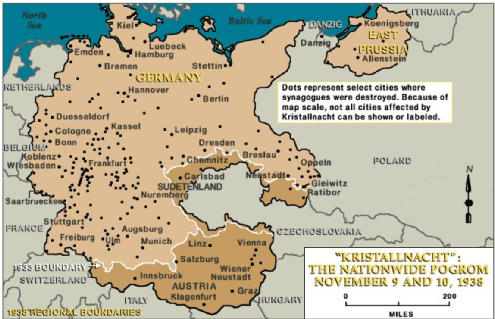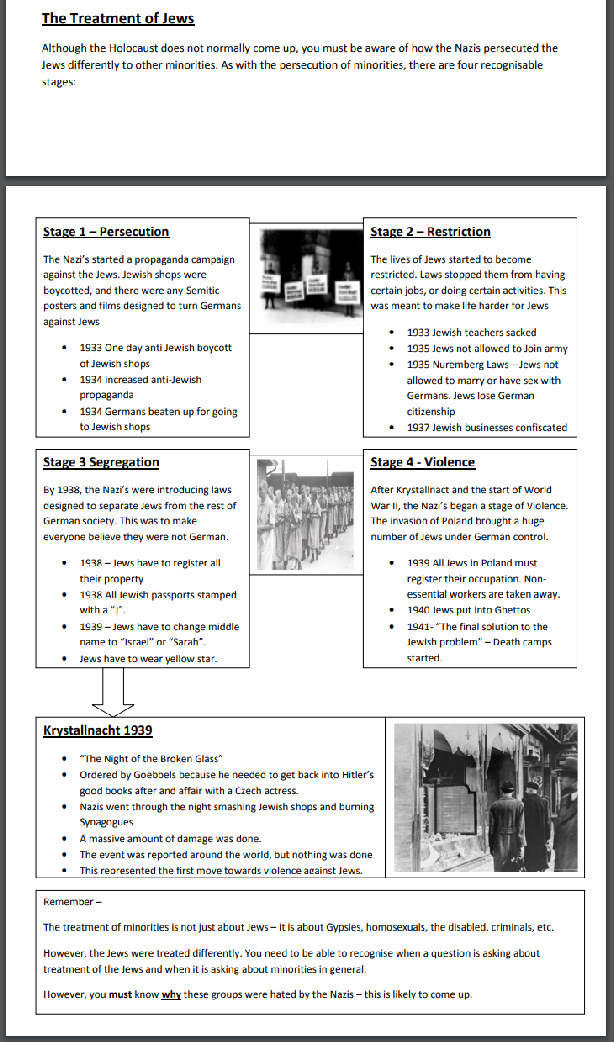|
CLICK BUTTON TO GO |
|
|
|
|
|
|
|
|
|
|
|
|
|
Videos |
|
|
|
|
|
|
|
|
|
|
|
|
|
PART 1 T O P I C |
|
|
|
|
|
|
|
|
|
|
|
|
|
|
|
|
|
|
JewishWikipedia.info
|
When did the Holocaust Actually Begin? |
The Night of Broken Glass Review Eyewitness Accounts |
WHEN DID THE HOLOCAUST ACTUALLY BEGIN?
THE ANSWER IS NOT SO SIMPLE.
The Holocaust was the single-most traumatic event for the Jewish people in the 20th century, but there is some disagreement over the exact date on which it started.
Haaretz, Feb 17 2014
The term Holocaust (with a capital H) is commonly used to refer to the systematic murder by Nazi Germany of approximately six million Jews and the destruction of their communities, representing one-third of world Jewry at the time. In this use, it is analogous to the Hebrew word Shoah, also used to refer to the genocide committed against the Jews. Sometimes Holocaust is also used in a broader sense, to refer to all of the victims of Nazi state-organized murder, including the Roma, gay people and others.
The Nazi genocide and ethnic cleansing efforts did not begin as a specific plan to gas Jews and others in concentration camps, but rather evolved over time, beginning with systematic persecution aimed in part at encouraging Jewish emigration from Germany to other countries. It grew from spontaneous murders to planned massacres of Jewish communities, to the establishment of an industrial apparatus for the efficient, wholesale slaughter of a people.
In recognition of the evolving nature of the genocide, the date most frequently associated with the start of the Holocaust is January 30, 1933: This is when Adolf Hitler was appointed German chancellor, setting in motion what would become the Nazi genocide against the Jews. The end of the Holocaust is usually thought to be May 8, 1945, or VE (Victory in Europe) Day, when the Allies formally accepted Germany’s unconditional surrender, ending World War II on the Continent, although fighting continued in the Far East.
WHEN DOES PERSECUTION BECOME GENOCIDE?
A major turning point in Nazi policy toward Jews was the coordinated attacks by the Sturmabteilung (or SA, the original paramilitary wing of the Nazi Party) against Jews and Jewish institutions and businesses throughout Germany and Austria on November 9-10, 1938 – an event known as Kristallnacht or the Night of the Broken Glass, due to the large amount of shattered windows at Jewish properties in its aftermath. At least 91 Jews were killed in the violence, and 30,000 were arrested and interned in concentration camps (but not extermination camps). Over 900 synagogues and 7,000 Jewish businesses were severely damaged or destroyed.
Kristallnacht marked the transition of the Nazi policy vis-a-vis Jews from social ostracism, abrogation of legal rights and economic boycotts, to organized physical violence including murder. As such, some consider the November ‘38 pogrom as marking the actual beginning of the Holocaust – the date when anti-Jewish persecution in Germany began moving toward genocide.
Mass killings of Jews became commonplace following the Nazi invasion of the Soviet Union on June 22, 1941. Death squads called Einsatzgruppen, formed at the order of Reinhard Heydrich, director of the Reich Main Security Office at the time, were tasked with murdering Jewish civilians and Communist Party officials with the help of local citizens. Historians estimate that between June 1941 and May 1943, these roaming death squads killed over 1 million Jews.
Industrial-scale murder of Jews, known as the Final Solution, was approved by the senior Nazi leadership on January 20, 1942 at the Wannsee Conference, held just outside Berlin. At the meeting, called by Heydrich, he presented the plan to transport Jews from Eastern and Western Europe to extermination camps located in Poland.
While the fall of the Nazi regime and its surrender on May 8, 1945 is usually the date given as the end of the Holocaust – it did not mark the end of organized killings of Jews in Europe. Hundreds of Jews were killed across Poland by Polish locals after the war had ended. In the most of infamous of these events, on July 4, 1946, over 40 Jews were killed in the Polish city of Kielce, in a massacre incited by Polish communist authorities with elements among the local population participating.
NEW YORK TIMES REPORT ON KRISTALLNACHT,
NOVEMBER 10, 1938
The events of Kristallnacht in Munich and other cities around Germany.
New York Times
JEWS ARE ORDERED TO LEAVE MUNICH
Some Told They Must Get Out of Germany Despite Fact They Lack Passports
FINE SHOPS ARE WRECKED
Four Synagogues Set On Fire in Frankfort on the Main, Many Jews Arrested
MUNICH, Germany, Nov. 10-All Jewish families were ordered this morning to leave Munich within forty-eight hours and were instructed to inform the political police by 6 P.M. when they would hand over the keys to their dwellings and garages.
Instructions were issued to confiscate all Jewish-owned cars and the sale of gasoline to Jews was forbidden. In some cases Jews were told that they must leave Germany and they were forced to sign a statement to this effect. No notice was taken of the objection that most Jews were without passports. The only Jews with passports are those who have already made preparations to emigrate.
The news of the death of Ernst vom Rath in Paris was the signal for a reign of terror for the Jewish community in Munich, which began with the wrecking of shops during the night and continued with incendiarism during the morning and wholesale arrests and notices of expulsions during the day.
CROWDS FILL MAIN STREETS
Large crowds filled the main streets this morning to gaze on the destruction wrought in last night’s riots, the full extent of which was visible only by daylight. Kauffingerstrasse, one of Munich’s main streets, looked as if it had been raided by a bombing lane. A half-dozen of the best shops were converted into wreckage overnight with plate-glass windows splintered on the pavement, shelves torn down and goods lying broken and trampled on the floor.
So far as can be gathered every Jewish-owned shop in town was completely or partly wrecked as well as several “Aryan”businesses, which shared the general fate for having previously belonged to Jews.
An orthodox synagogue was set on fire early this morning; the alarm was raised about 8 A.M. but the flames caused much havoc before they could be controlled. The synagogue was reduced to a shell and the Jewish school adjoining it was also completely burned. It was reported that synagogues in Bemberg, Bayreuth and Treutlingen were also burned.
Arrests of male Jews began at their homes at an early hour. It was estimated that so far about 400 had been taken into custody and also a half dozen women.
The windows of the well-known banking house of H. Aufhaeuser were stoned last night and this morning a Nazi commissar took control of the business which was already in the process of being “Aryanized.” Aufhaeuser is one of Germany’s most important banking concerns. Martin Aufhaeuser, the senior partner, was arrested. Another partner, Emil Kramer and his wife killed themselves at their home today.
he home of Karl Bauch, a wealthy manufacturer who was arrested today, was set on fire last night. Among other prominent Jews taken into custody were three well-known surgeons, Professor Alfred Haas and Dr. Josef Rosenbaum (both of them had received permits to go to England) and Dr. M. Klar, Munich’s leading orthopedic surgeon. Some Jews escaped arrest by remaining away from their homes and offices. [. . .]
REPORTS FROM OTHER TOWNS
BERLIN, Nov. 10.—The wave of destruction of Jewish synagogues, homes, shops and other buildings in towns outside Berlin was reported as follows in the press today:
Eberswalde: Roof and interior of the synagogue in the Bismarckstrasse opposite ancient city walls destroyed by fire this morning.
Stettin: The Jewish temple opposite the Gruene Schanze(green buwards or barricade) was ablaze this morning. The fire brigade was unable to save any of the contents of the building and military pioneers were called to blast the ruins.
Landsberg: The synagogue’s interior was ruined by fire in the early hours this morning.
Konstanz on the Bodensee: The synagogue was destroyed this morning.
Cologne: Jewish-owned shops were attacked and the Cologne synagogue was burned down last night.
Luebeck: Jewish-owned shops were demolished and synagogue windows smashed.
Leipzig: The windows of Jewish-owned shops were smashed and the Bamberger and Hertz Company, a department store, was set on fire as well as the synagogue.
Nuremberg: Jewish-owned shops were demolished.
Essen: In Essen and Dusseldorf the synagogues were reported blazing. A larger Jewish youth home at Essen, just completed, was burned down.
Hamburg: Furious crowds demonstrated before Jewish-owned shops. Synagogues were attacked.
Potsdam: Jewish-owned shop windows were smashed and a synagogue on the Wilhemplatz also suffered. Weapons were reportedly found in them.
Brandenburg: A Jewish temple was burned down.
A Jewish refugee's assassination of a German official in Paris in 1938 sparked the German attack on Jews known as Kristallnacht
Kristallnacht: Guardian report on how the night unfolded
Guardian 9 Sep 2009
The operation of the wreckers of Jewish shops and places of business were in two parts. First, small wrecking squads, who began their work as early as two in the morning in some cases, smashed the windows and showcases of Jewish-owned premises, whether the proprietors were foreign Jews or German Jews. All Jewish shops are marked with special signs, which facilitated their work. The first squads, working quickly and in darkness, only dealt, however, with the Jewish premises on main streets. When Berlin went to work this morning it experienced the extraordinary sight of wholesale smashed windows with dummy figures and the like leaning out on to the street; nothing, however, was then plundered.
But at about midday the work of the original squads was supplemented by the wreckers proper. They operated too in small bands and were followed by crowds of supporters who proceeded to smash the interiors of the Jewish shops to pieces and in many cases to throw the goods in them out into the streets. These wreckers in their turn were supplemented by others, including many youngish boys. They seized whatever implements they could find and absolutely broke up everything to hand.
In some parts of Berlin, foodstuffs, clothes, underclothing – and even furs – were thrown out to the crowds. In other shops none of the contents, apart from the windows and fittings, were touched until this evening. Plundering did not seem to be the purpose of the wreckers themselves. Where there was plundering they threw out the contents of the shops to the crowds standing outside.
Manchester Guardian, 11 November 1938
GOEBBELS' STATEMENT AFTER THE ATTACKS
Dr Goebbels, the propaganda minister, did not deny the good faith of the eyewitness reports of the devastation of Jewish property yesterday when he received the foreign press at the ministry this afternoon. He declared that they were spontaneous manifestations of indignation against the murder of Herr vom Rath by the young Jew Grynszpan. He added that the accounts of witnesses varied even in good faith. He himself was in Munich and only heard about the demonstration by telephone.
He thought the Jews were stupid people. If they had a clever head among them they would be advised never to mention Germany at all. He himself counselled foreign newspapers not to insult the Reich if they wished to serve the interests of the Jews. But, while Germany did not intend to give an example to the world, Goebbels declared that the antisemitic instinct slumbered among all nations.
Manchester Guardian, 12 Nov 1938
THE NIGHT OF BROKEN GLASS
EDITED BY UTA GERHARDT AND THOMAS KARLAUF –
REVIEW EYEWITNESS ACCOUNTS OF KRISTALLNACHT
Richard J Evans's ‘The Third Reich at War’ is published by Penguin.
The Guardian 11 Apr 2012
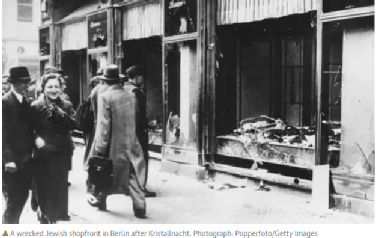
A wrecked Jewish shopfront in Berlin after Kristallnacht. Photograph: Popperfoto/Getty Images
This riveting book prints a collection of 21 eyewitness accounts by German Jews of the terrible night of 9 November 1938, when, on the orders of Adolf Hitler and his propaganda minister Joseph Goebbels, bands of stormtroopers all over Germany and Austria burned down more than 1,000 synagogues and smashed up some 7,500 Jewish-owned shops. The shards of shop windows that littered the streets on the morning of 10 November led Berliners, with typically bitter humour, to dub the events of the previous hours the "Reich Night of Broken Glass", satirically imitating such Nazi events as the "Reich Day of Labour".
Hitler had used the murder of a minor official in the German embassy in Paris by a Polish Jew protesting against the expulsion of his parents from Germany as an excuse for the pogrom. The stormtroopers were fuelled by anger as well as by alcohol, their antisemitic passions inflamed by lurid accounts of the killing in Goebbels's propaganda press. As the destruction proceeded, Jewish homes were broken into and the contents looted or smashed, the occupants manhandled, beaten up or, in a substantial number of cases, murdered. Hitler ordered 30,000 Jewish men to be arrested and taken to concentration camps; their release came only when they agreed to emigrate.
By the outbreak of the war in September 1939 the Jewish population of Germany was half what it had been when the Nazis came to power. After their arrival in England, America, Palestine, Shanghai or some other safe haven, the Jewish emigrants found an opportunity to recount their experiences when three Harvard academics, the historian Sidney Fay, the psychologist Gordon Allport and the sociologist Edward Hartshorne, offered a monetary reward (top prize $1,000) for "the best unpublished personal life histories of persons who have experienced the effects of National Socialism in Germany". The purpose, they said was "purely scientific". Two hundred and sixty-three essays came in, mostly though not exclusively from Jews who had emigrated after the pogrom.
Uta Gerhardt and Thomas Karlauf have selected for publication 21 of these accounts from a manuscript prepared by Hartshorne. Entitled Nazi Madness, it was never published. Hartshorne had edited his selected narratives and reorganised them to increase their impact.
The testimonies recount a wide variety of experiences. For Hugo Moses, a former bank official, the behaviour of the drunken mob of stormtroopers who broke into his apartment on the night of 9 November, overturning his furniture and smashing his ornaments and pictures, while an SS man held a loaded revolver to his head, contrasted with the policemen who came to inspect the damage and told him apologetically: "It's a disgrace to see all this." Public reaction in general, as reported in these memoirs, was mixed: some Germans gathered in jeering mobs, others stood by muttering disapproving comments. Nobody intervened.
Sofoni Herz, a teacher at a Jewish orphanage in Dinslaken, a mining town in the Ruhr, hurriedly took 32 children outside while a gang of 50 men systematically destroyed everything in the building, "shattering window panes, throwing books, chairs, beds, tables, linens, maps, valises, piano parts, etc out of the windows and doors" before setting the orphanage's synagogue on fire. A Nazi official announced "that we have ordered that the cow belonging to the orphanage, which is taken care of by a German farmer, will continue to be fed. Animals must not suffer on this day." The children and staff were imprisoned in a room in the city, where local policemen apologised to them: "we're all still good Social Democrats or Democrats. But what can we do in times like these?"
Some of these reminiscences tell other stories too. A Nazi teacher persecuted Hugo Moses's nine-year-old son in the classroom, making him sit on a bench on his own, refusing to correct his work and banning him from using the school swimming pool: "You are not allowed to contaminate German water." The boy later told his father he would have thrown himself under a train had this continued much longer. The head teacher, though sympathetic to the father's protests, confessed he could do nothing, because he would lose his job if he did.
But almost all the memoirs focus on the events of 9-10 November 1938. Particularly harrowing are the stories of what happened to the Jewish men arrested and taken off to the camps. The shopkeeper Karl Schwabe endured "a series of endless physical and mental sufferings" at Buchenwald. In the first days they were deprived of food and drink – "our mouths dried out completely, our throats burned". They were forced to stand outside in rows for hours, with the SS mercilessly hitting and kicking anyone who fell over. Many were beaten to death; others, unable to bear the torture, ran into the electrified barbed wire fences. Elderly men were forced to do squats until they dropped from exhaustion. "The sanitary conditions", Schwabe wrote, "defy description."
Karl Rosenthal, a reform rabbi in Berlin, recounted the repeated humiliations to which prisoners were subjected, as they were forced under blows to chant "we are the destroyers of German culture!" Social envy was behind many of the insults. "Your profession?" an SS man asked one of the prisoners. "Former lawyer." "Bullshit, you're a pimp! Repeat it!" Psychological torture accompanied the beatings, as the men were lined up and told "tonight 3,000 Jewish kids will be shot in Berlin".
The men were released on condition they emigrated. But this was far from easy. Hertha Nathorff, head physician at a major hospital in Berlin until September 1938, related her repeated attempts to gather the funds, documents and permissions to go with her husband to Cuba and thence to the US: bribery and extortion were part of the process, and by New Year's Eve 1938 she still had not got away: "I'm just counting the days until we can get out of this hell."
The value of these testimonies lies above all in their detail and immediacy. Mostly they confirm the picture we already have from other sources, though few are as vivid as these. Collecting the testimonies was, despite the assurances of the Harvard professors, by no means a "purely scientific" exercise. For Hartshorne in particular, the Third Reich was an abomination. In the mid-1930s he had lived in Berlin gathering material for his PhD on the destruction of the universities by National Socialism. Later, he urged the neutral US to mobilise against what he regarded as the rule of a criminal clique in Germany.
Nazi Madness was to have been a contribution to his campaign against American isolationism. It remained unpublished because Hartshorne was drafted into government service once the US entered the war, and lacked the time to see it through the press. In 1945 he was put in charge first of re-establishing German universities, and then of denazification in Bavaria, with further heavy demands on his time.
Hartshorne's anti-Nazi convictions aroused the hostility of the US military government's Counter-Intelligence Corps, the CIC, which was smuggling Nazi war criminals out of Soviet-occupied Austria and eastern Europe to Italy and thence South America, to be questioned about their knowledge of the Soviets for use in the looming cold war. Informed of these activities, Hartshorne was outraged and passed on information about this "ratline" to Moscow. He had become a serious inconvenience to the CIC. On 28 August 1946, on the Munich-to-Erlangen autobahn, his car was overtaken by a Jeep, which suddenly slowed down in front of him, forcing him to overtake it in turn. As he passed, a single shot was fired from the jeep, hitting him in the head. He died two days later. The murderer was never identified.
German Jewish Refugees, 1933 -1939 Yad Vashem
KRISTALLNACHT, 1938
THE NIGHT OF BROKEN GLASS
alfapres 2012 (15.26)
KRISTALLNACHT, 1938
NIGHT OF BROKEN GLASS
Kim Angell 2013 (1.28.11)
Go to Germany for more details about the Nazis
and to Kindertransport for saving children’s lives
KRISTALLNACHT:
THE HOLOCAUST BEGINS
ON THE 15TH ANNIVERSARY
OF THE BEER HALL PUTSCH
Hardcore History 2018 (28.10)
From a BBC documentary series
"Days That Shook the World".
The Nazis initiated the Kristallnacht Pogrom (also known as "The Night of Broken Glass") on Nov 9 & 10, 1938, which was the
15th Anniversary of Hitler's Beer Hall Putsch (Nov 9, 1923).
More than 1,000 synagogues were burned or otherwise damaged. Rioters ransacked and looted about 7,500 Jewish businesses, murdered at least 91 Jews, and vandalized Jewish hospitals, homes, schools, and cemeteries. Some 30,000 Jewish males aged 16 to 60 were arrested. The concentration camps at Dachau, Buchenwald, and Sachsenhausen were expanded to accommodate the new prisoners. Kristallnacht marks the first instance in which the Nazi regime incarcerated Jews on a massive scale, simply on the basis of their ethnicity, and is recognized by many historians
as the beginning of the Holocaust.
KRISTALLNACHT (NIGHT OF BROKEN GLASS),
NOVEMBER 9 &10, 1938
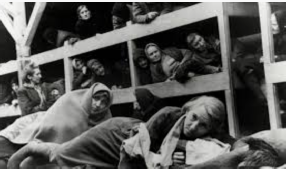
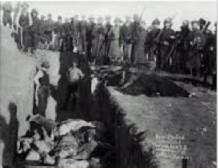
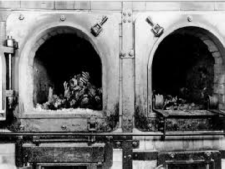
THE
INCREDIBLE
STORY OF THE JEWISH PEOPLE

